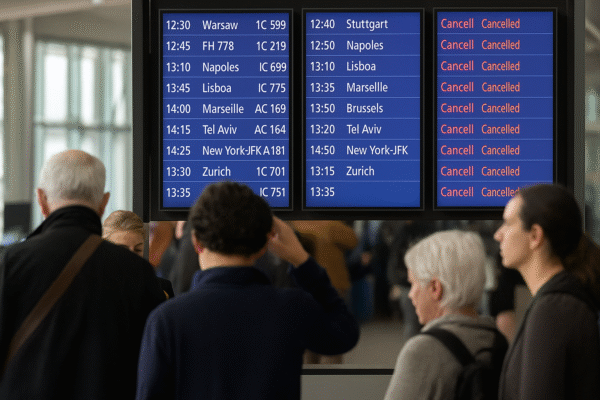Over 3,300 Flights Disrupted Across Asia as Severe Weather Hits Key Travel Hubs in China, India, Japan, and Southeast Asia
July 6, 2025 – In a sweeping display of how vulnerable Asia’s aviation network remains to meteorological disruption, over 3,300 flights were delayed and more than 60 cancelled across major international airports including Beijing Capital, Shanghai Pudong, Tokyo Haneda, Delhi Indira Gandhi, and Singapore Changi. Leading airlines—China Eastern, Air China, ANA, Singapore Airlines, IndiGo, and Japan Airlines—faced operational strain amid a convergence of localized storms, fog, lightning activity, and shifting monsoon fronts.
The region’s aviation system, already operating at high summer capacity, buckled under pressure from seemingly moderate but cumulatively impactful weather systems. Ground delays, air traffic rerouting, and runway slowdowns rippled across more than two dozen cities, revealing growing infrastructure stress under unpredictable climate patterns.
China: Massive Delays from Beijing to Guangzhou
Beijing’s two international airports—Capital and Daxing—reported over 370 flight delays and 20+ cancellations, triggered by light precipitation, fog, and low-level cloud ceilings. Shanghai Pudong saw over 290 delays, with visibility issues stalling morning departures. Meanwhile, Guangzhou Baiyun and Shenzhen Bao’an bore the brunt, logging 400 and 430 delays, respectively, amid humid subtropical systems.
Kunming, Chengdu, Xi’an, and Hangzhou also experienced flight sequencing delays due to unstable air masses and apron water accumulation. According to the China Meteorological Administration, intermittent rain bands and high dew point values were to blame.
India: Monsoon Chaos Disrupts Delhi, Mumbai, and the South
India’s Indira Gandhi International Airport in Delhi led the disruption tally with over 230 delays and 3 cancellations, primarily due to fog and early morning wind shear. Mumbai dealt with monsoon-induced flooding on the runway, causing 160 delays and 7 cancellations. In the south, Bengaluru, Chennai, Hyderabad, and Kochi collectively saw over 250 delays as regional monsoon systems introduced fog, wind, and ground handling delays.
Meteorologists from the India Meteorological Department (IMD) highlighted a combination of high humidity and low-pressure troughs moving across central and southern India, complicating descent and departure planning.
Japan and Korea: Fog and Humidity Hit Summer Travel
Tokyo Haneda and Narita faced nearly 230 total delays, as marine fog and coastal humidity complicated takeoffs and landings. Similar patterns were observed at Osaka Kansai and Sapporo New Chitose. Airlines were forced into longer holding patterns, according to the Japan Civil Aviation Bureau (JCAB).
In South Korea, Incheon and Gimhae airports recorded a combined 330 delays, with marine fog and unstable descent paths forcing aircraft to adjust approach angles multiple times.
Southeast Asia: Singapore, Bangkok, and Jakarta Experience Widespread Gridlock
Singapore Changi, one of the world’s busiest aviation hubs, logged over 290 delays, largely due to lightning warnings and apron closures. Tropical instability over the Strait of Malacca extended inbound aircraft sequencing into the evening.
In Thailand, Don Mueang Airport reported 140+ delays, while Bangkok Suvarnabhumi experienced slower recovery rates after thunderstorm warnings.
Jakarta Soekarno-Hatta saw one of the highest disruptions—460 delays and 20 cancellations—amid intense lightning, prompting terminal-wide slowdowns. Neighboring airports in Bali and Surabaya logged over 250 delays combined.
Vietnam and Malaysia: Monsoon Bands Trigger Delays
Vietnam’s Tan Son Nhat (Ho Chi Minh City) and Noi Bai (Hanoi) airports were also heavily affected, with over 400 delays. Afternoon thunderstorm cells forced ramp closures during peak hours.
Kuala Lumpur International Airport (KLIA) saw 350 delays, mostly in the evening, as saturated cloud cover led to holding patterns and diverted flights. Penang and Kota Kinabalu also saw moderate operational slowdowns.
Middle East Impact: Gulf Sandstorms Affect UAE and Saudi Routes
Though more limited in scale, the weather chaos extended to Gulf hubs such as Doha, Dubai, Abu Dhabi, and Jeddah, which faced visibility issues due to dust storms and strong desert winds. Doha Hamad International recorded 95 delays and over a dozen cancellations, per Qatar Airways’ operational updates.
Experts: Subtle Weather Shifts Becoming Major Operational Risk
While no typhoon or severe storm system was at play, aviation meteorologists across the region note that “subtle but widespread meteorological triggers”—including humidity-driven fog, surface wind shear, and low-level cloud decks—have proven enough to stall even the most modern hubs.
“As aircraft sequencing becomes more tightly packed and apron activity reaches maximum saturation during summer peaks, even mild disruptions now carry exponential consequences,” noted an ICAO official based in Bangkok.
What’s Next for Travelers and Operators?
With weather-related disruptions on the rise during Asia’s 2025 summer travel surge, airline operators are under pressure to invest in faster ramp resumption protocols and real-time data forecasting tools. Meanwhile, regional aviation authorities, including India’s DGCA, China’s CAAC, and Japan’s JCAB, are coordinating to enhance inter-airport communication and predictive delay modeling.
Travelers flying in or out of Asia are advised to:
- Monitor airline apps and airport dashboards frequently
- Opt for flexible fare bookings
- Arrive early, especially at high-traffic airports
- Prepare for gate reassignments or overnight re-accommodation in worst-case scenarios
Despite clearing skies in some sectors, forecasts suggest continued instability over India, Southeast Asia, and parts of southern China throughout the week.
For more travel news like this, keep reading Global Travel Wire


















